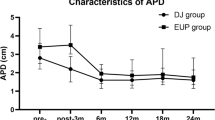Abstract
Purpose
Placement of an antegrade double-J (JJ) ureteric stent is an important component of pyeloplasty. Correct siting of distal end of the stent in the bladder is essential for ease of removal. To date, no studies have compared methods for confirming stent position. This study aims to address that void in the literature.
Methods
Eligible patients underwent laparoscopic pyeloplasty with antegrade stent placement at our institution from 2007 to 2015 inclusive. Methods to verify distal stent position of rigid cystoscopy, artificial bladder filling or no confirmation were compared. Effectiveness was determined by the proportion of malpositioned stents detected intra-operatively compared to the total found malpositioned, both intra-operatively and during follow-up.
Results
A total of 75 patients underwent laparoscopic pyeloplasty. Forty-six (61.3%) patients had distal stent position assessed intra-operatively, comprising 27 by cystoscopy and 19 by artificial bladder filling, while for 29 (38.7%) patients no verification method was used. Cystoscopy, artificial bladder filling and no confirmation detected intra-operatively 2, 1 and 0 malpositioned stents, from malpositioned stent totals of 2, 2 and 1, respectively.
Conclusion
Malposition of JJ ureteric stent is uncommon, and omitting intra-operative position verification appears reasonable in select cases. Artificial bladder filling can help detect malpositioned JJ stents without repositioning the patient for cystoscopy. However, our results suggest both may be unreliable. If stent malposition is suspected, certainty is desired or extended operative duration is less critical, then the surgeon should proceed with cystoscopy.


Similar content being viewed by others
References
Liang CC, Cheng PJ, Lin CJ et al (2002) Outcome of prenatally diagnosed fetal hydronephrosis. J Reprod Med 47(1):27–32
Notley RG, Beaugie JM (1973) The long-term follow-up of Anderson–Hynes pyeloplasty for hydronephrosis. Br J Urol 45(5):464–467
O’Reilly PH, Brooman PJ, Mak S et al (2001) The long-term results of Anderson–Hynes pyeloplasty. BJU Int 87(4):287–289
Inagaki T, Rha KH, Ong AM et al (2005) Laparoscopic pyeloplasty: current status. BJU Int 95(Suppl 2):102–105
Boylu U, Basatac C, Turan T et al (2012) Comparison of surgical and functional outcomes of minimally invasive and open pyeloplasty. J Laparoendosc Adv Surg Tech A 22(10):968–971
Schwentner C, Pelzer A, Neururer R et al (2007) Robotic Anderson–Hynes pyeloplasty: 5-year experience of one centre. BJU Int 100(4):880–885
Shah KK, Louie M, Thaly RK et al (2007) Robot assisted laparoscopic pyeloplasty: a review of the current status. Int J Med Robot 3:35–40
Chow K, Adeyoju AA, Section of Endourology of the British Association of Urological Surgeons (2011) National practice and outcomes of laparoscopic pyeloplasty in the United Kingdom. J Endourol 25(4):657–662
Singh O, Gupta SS, Hastir A et al (2010) Laparoscopic dismembered pyeloplasty for ureteropelvic junction obstruction: experience with 142 cases in a high-volume center. J Endourol 24(9):1431–1434
Rodriguez AR, Rich MA, Swana HS (2012) Stentless pediatric robotic pyeloplasty. Ther Adv Urol 4(2):57–60
Mandhani A, Goel S, Bhandari M (2004) Is antegrade stenting superior to retrograde stenting in laparoscopic pyeloplasty? J Urol 171(4):1440–1442
Yiee JH, Baskin LS (2011) Use of internal stent, external transanastomotic stent or no stent during pediatric pyeloplasty: a decision tree cost-effectiveness analysis. J Urol 185(2):673–680
Elmalik K, Chowdhury MM, Capps SN (2008) Ureteric stents in pyeloplasty: A help or a hindrance? J Pediatr Urol 4(4):275–279
Smith KE, Holmes N, Lieb JI et al (2002) Stented versus nonstented pediatric pyeloplasty: a modern series and review of the literature. J Urol 168(3):1127–1130
Dong J, Wong J, Al-Enezi A et al (2008) Laparoscopic pyeloplasty: the updated McMaster University experience. Can Urol Assoc J 2(4):388–391
Chandrasekharam VV (2005) Is retrograde stenting more reliable than antegrade stenting for pyeloplasty in infants and children? Urology 66(6):1301–1304 (discussion 1304)
Minervini A, Siena G, Masieri L et al (2009) Antegrade stenting in laparoscopic pyeloplasty: feasibility of the technique and time required for stent insertion. Surg Endosc 23(8):1831–1834
Derouiche A, El Atat R, Ben Slama MR et al (2009) Endoscopic bridge operating-guide device applied for intracorporeal antegrade ureteric stenting during laparoscopic pyeloplasty. J Endourol 23(11):1871–1874
Singh KM, Goel A, Shankhwar SN et al (2004) Confirmation of the correct placement of lower end of DJ stent during open surgery: point of technique. Int Urol Nephrol 36(3):335–336
Noh PH, Defoor WR, Reddy PP (2011) Percutaneous antegrade ureteral stent placement during pediatric robot-assisted laparoscopic pyeloplasty. J Endourol 25(12):1847–1851
Rodrigues H, Rodrigues P, Ruela M, Bernabé A, Buogo G (2002) Dismembered laparoscopic pyeloplasty with antegrade placement of ureteral stent: simplification of the technique. Int Braz J Urol 28(5):439–444
Chen Z, Chen X, Luo YC (2011) Technical modifications of double-J stenting for retroperitoneal laparoscopic dismembered pyeloplasty in children under 5 years old. PLoS ONE 6(8):e23073
Guarantor
D. Hennessey.
Authors’ contribution
AT conceived the study. CH was involved in protocol development. DH wrote the first draft of the manuscript. ME and NK reviewed and edited the manuscript.
Author information
Authors and Affiliations
Corresponding author
Ethics declarations
Conflict of interest
None.
Informed consent
Written informed consent was obtained from the patients included in the study for their anonymised information to be published in this article.
Ethical approval
Ethics approval for this study was granted by the Austin Health Human Research Ethics Committee, reference LNR/16/Austin/470.
Rights and permissions
About this article
Cite this article
Hennessey, D.B., Kinnear, N.J., Evans, R.M. et al. Is confirmation of ureteric stent placement in laparoscopic pyeloplasty necessary?. Int Urol Nephrol 49, 931–936 (2017). https://doi.org/10.1007/s11255-017-1560-8
Received:
Accepted:
Published:
Issue Date:
DOI: https://doi.org/10.1007/s11255-017-1560-8




